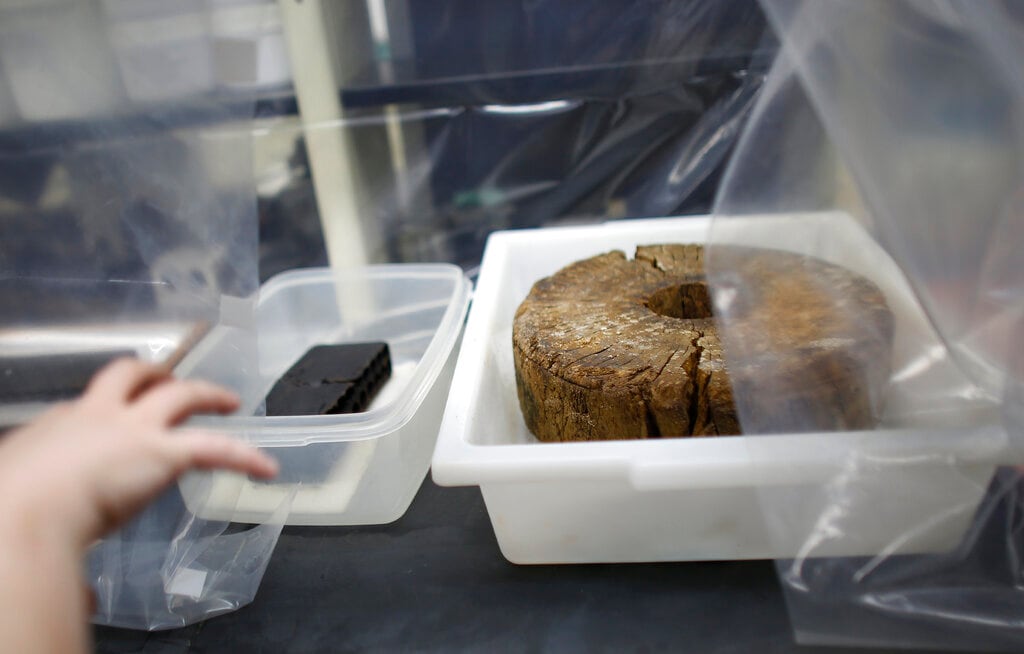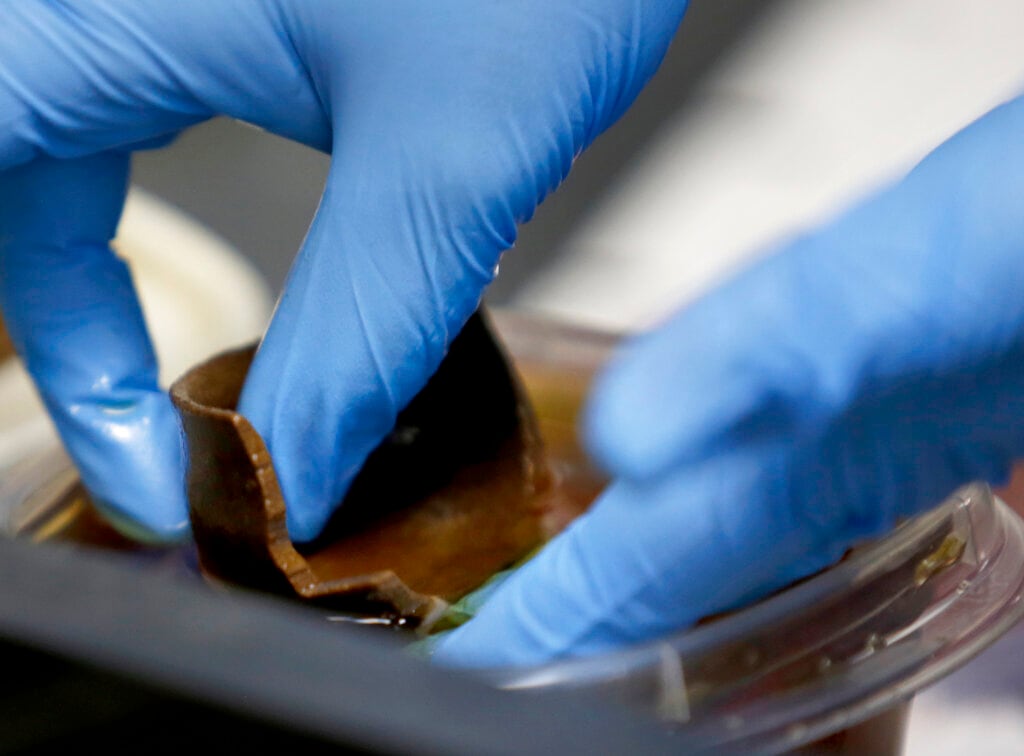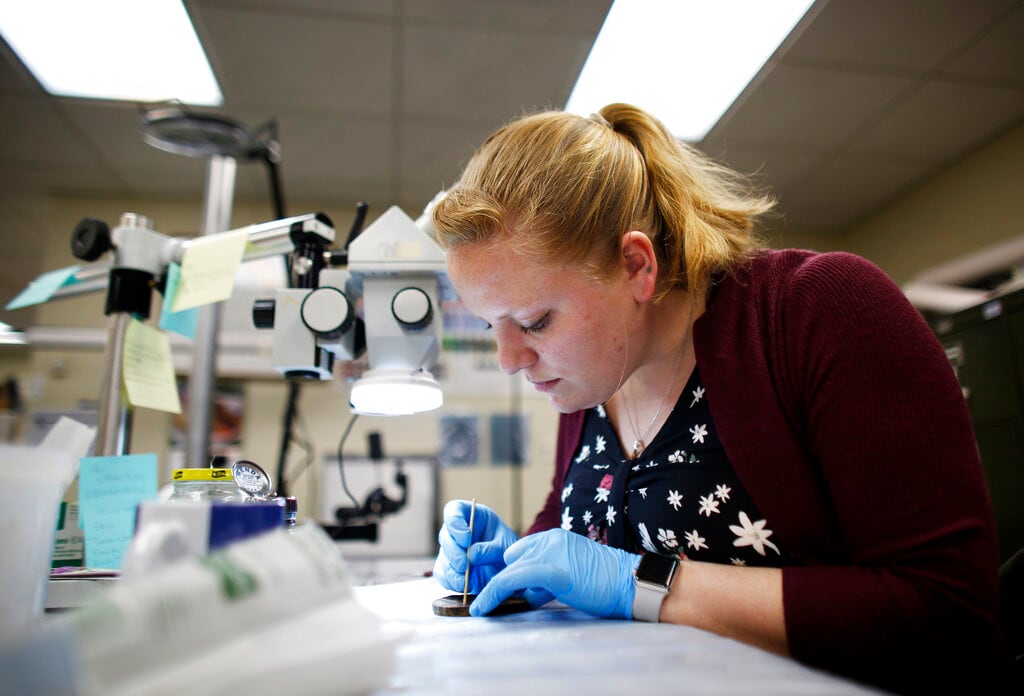RICHMOND, Va. — In an uh-oh episode of historic proportions, hand grenades from the last major battle of the Revolutionary War recently and repeatedly scrambled bomb squads in Virginia’s capital city.
Wait — they had hand grenades in the Revolutionary War?
Indeed. Hollow iron balls, filled with black powder, outfitted with a fuse, then lit and thrown.
And more than two dozen have been sitting in cardboard boxes at the Department of Historic Resources, undetected for 30 years.
Encrusted and corroded, no one realized what the grenades were when they were excavated in the 1980s along with 5,000 other relics from The Betsy, a British ship sunk in the York River in 1781. Analysis that would normally have been conducted after such a find was shut down by state budget cuts.
So the grenades went on the shelves — labeled with the best guess of "shot" — alongside 6 million other artifacts housed in the state's repository.
The first grenade was noticed around Thanksgiving, thanks to a conservation grant that had staff sifting through boxes to see how relics were holding up. The last was rounded up just before New Years.
And yes, they were still live.
More volatile than ever.

The repository at the Department of Historic Resources is full of ghosts.
Sheltered in rented space alongside the Virginia Museum of History and Culture, it’s a library of rolling shelves and 9,000 boxes holding countless artifact-filled plastic bags preserving the remnants from centuries of lives. Arrowheads and pottery. Pipes and pieces of planks. Bottles, buttons and buckles. Anything old that’s been unearthed by archaeologists or found and donated.
Live ordnance has shown up at the door before, brought by folks who didn't recognize what they'd dug up in their garden.
"But it's usually Civil War stuff," said Kate Ridgway, a conservator with the department. "You still get quite a bit of that around here."
Standard protocol: Call the police for disposal.
"We hate to see anything historic destroyed," Ridgway said, "but it's just too dangerous to keep."
Staff had no idea what they were holding onto themselves.
The first thorough inspection of Betsy artifacts began in the fall after the department landed a Maritime Heritage grant from the National Park Service. It covered the cost of examining and re-treating, if necessary, the "organics" in the collection — pieces of wood, rope, leather and the like that are most vulnerable to decay.
When originally preserved, they were soaked in chemicals and "bulking agents" that tend to degrade over time. Better techniques have been developed.
"So there I was," said Chelsea Blake, a conservator hired to handle the project, "going through old records and boxes, trying to match things up. As I came across metal items — since that's not an organic — I'd set them aside in a box I'd marked 'Things for Kate' so she could take a look later."
On Nov. 28, Ridgway was working her way through that box in the lab when she pulled out a plastic bag labeled "shot." Inside: a gray-ish round clump not much bigger than a golf ball.
"I knew right away something wasn't right," Ridgway said. "It wasn't heavy enough to be lead shot. And it had these weird cracks in it. And what looked like crystals inside."
When she opened the bag, she caught the scent of something ominous.
A whiff of gunpowder crossed 237 years and drifted up.

In September 1781 — six years into the Revolutionary War — the siege at Yorktown was under way. Roughly 8,000 British troops were dug in, trapped against the river by twice as many troops from George Washington’s Continental Army and its French allies.
Most of the town lay in smoking ruins. Food was running low. But Lord Charles Cornwallis, the British commander, was holding out. He had a good supply of ammunition and a decent-sized fleet still afloat in the river. And he was expecting reinforcements. A British armada was on its way from New York.
But French warships fended off his rescuers, blocking their path at the entrance to the Chesapeake Bay. Fearing the French ships would then sail for Yorktown, Cornwallis made the desperate decision to sacrifice much of his own fleet, scuttling dozens of vessels to form a barrier of barely sunken wreckage in the river.
The Betsy was one of them. A 75-foot collier built of heart of oak in Whitehaven, England, the ship had been drafted into military service. Before dropping anchor in the York River, The Betsy carried British troops from Portsmouth to Yorktown. Then, on Sept. 16, 1781, a hole was chiseled in the ship's hull, and The Betsy sank to the bottom.
The scuttling strategy didn't change the outcome at Yorktown, of course. Cornwallis surrendered on Oct. 19, 1781 — sapping the will of the British empire to fight on. The French salvaged what they could from the crippled ships and locals picked through the remains.
In time, the ships settled deeper and the elements ate at their carcasses. What was left was eventually covered in a protective blanket of silt. And the lost fleet of Yorktown slept, largely forgotten.
John Broadwater started probing the river bed in the 1970s. Hired as the state's first underwater archaeologist, he led a team that found nine of the shipwrecks before efforts were focused on The Betsy. Located just 500 yards offshore in about 20 feet of water, the hull was intriguingly intact under five feet of silt.
Full-on excavation, which didn't start until the 1980s, was a big deal. It required a specially designed enclosure called a "cofferdam" to overcome the York River's strong currents, near-zero visibility and stinging jellyfish. National Geographic magazine published a spread on the Yorktown Shipwreck Archaeological Project in June 1988, dedicating 20 pages to the history, excavation and relics recovered — everything from a barrel still holding 10,000 musket balls to a window from the captain's quarters with glass still intact.
There was no mention of grenades. When they'd been found — waterlogged and heavy with a type of corrosion archaeologists call "concretion" — it was assumed they were shot for a small cannon that had also been recovered.
"We took some rough measurements and they seemed like they'd fit the cannon," Broadwater said. "We put them aside, along with all kinds of other stuff, for later study. We were planning to get them X-rayed to see what was inside."
Instead, a budget ax fell hard in 1989, slashing funding for the department and pulling the plug on the shipwreck project.
"Right in the middle of everything," Broadwater said, "we were all laid off. And the artifacts ended up getting stored wherever they could find room."
Thirty years later, Broadwater's brown beard has turned silver and he's accumulated quite a list of accomplishments. He's worked with James Cameron on deep-water studies of The Titanic. Led expeditions to The Monitor, a storied Civil War ironclad. Helped Jeff Bezos recover Apollo Saturn V booster engines.
But The Betsy got to his soul. Diving in such a murky river, you feel alone with a shipwreck's spirits. The small discoveries — a whistle shaped like a monkey, a scrap of yellow ribbon, a scuttlehole cut with astonishing precision — gave a pulse to the long-dead.
"Those are moments an archaeologist cherishes," Broadwater said. "I felt like I was touching somebody from the past."
He was stunned when he heard that the past has now reached out to rattle the present in Richmond:
"To think that we've been sitting on bombs all these years ... and that the powder could still be viable after two centuries underwater."

Ridgway figured it could be, especially after three decades of drying time. She carried that first strange ball to a microscope. Those were definitely crystals inside.
"I am not happy," she told Blake, before turning to her computer to search for information about weapons of The Betsy's era. It dawned on her that this ball could be the core of a grenade, what was left after the iron shell had long dissolved.
Ridgway crossed the lab to another instrument that identifies chemical elements. Sulfur. And potassium. The ingredients of gunpowder.
"I am really not happy," Ridgway said. "We're done here. Call the police."
Soon, a parade of emergency vehicles jammed Kensington Avenue out front.
"I didn't even know they had hand grenades during the Revolutionary War," said Mark Castillo, the Richmond bomb squad commander.
A bomb tech put on safety gear — the heavy, head-to-toe Kevlar suit of their trade. Employees were cleared out. No one knew what to expect.
Grenades typically need a hard outer shell to produce the kind of explosion that sends shrapnel flying. But this one's shell had broken down, leaving "bits of metal and rust inside the powder which makes it even more sensitive," Castillo said, "more unstable as time goes by."
The core was nestled inside a bomb truck, driven to a range, wired with explosives and detonated. When the whole thing blew, the core sent up its own plume of white smoke — the signature of burning black powder. "There was no doubt the material was still hazardous," Castillo said.
Two days later, the staff found three more.
Repeat bomb squad scene.
Three days later, another one turned up.
Repeat bomb squad scene.
"At that point," Blake said, "we realized we needed to check all 140 boxes of Betsy artifacts at one time so we didn't have to keep calling the bomb squad every day. I mean, what if we had a fire in the building? These things had to go."
Most of December was spent crafting plans and preparing the lab. Guided by the bomb squad and following munitions factory rules, they removed anything that could produce a static spark — plastic, scraping chairs, squeaky carts. Tables were covered with cotton fabric. Extra humidifiers were brought in. Flammable chemicals were carried away.
On Saturday, Dec. 29, they came in just after dawn — Ridgway, Blake, collections assistant Andrew Foster and archaeologist Mike Clem.
All other employees had been told to stay away. Neighbors across the street had been notified with a letter. Experts from an alphabet soup of agencies — FBI, ATF, bomb techs from the city, county and state police — met the four at the lab, parking in a side lot to avoid causing a scene.
The fire department and medics stood by.
"We didn't want to endanger anyone else, but we didn't want to panic them either," Ridgway said. "We did whatever law enforcement advised us to do."

The bomb squads provided helmets, vests and thick aprons for the staffers, who had come to work dressed only in cotton clothing and rubber-soled shoes. Each staffer was assigned a personal bomb tech handler.
"We had 18 people in here," Ridgway said. "We couldn't have asked for better help."
Eight hours later, they'd combed through every single box. And found 20 more grenades. One was still wearing its iron jacket.
All were carefully carried away and detonated — the final shots of a war fought more than two centuries ago.
"Those were the oldest explosives we've ever dealt with, for sure," Castillo said.
Staff went home exhausted.
"That was a really long day," Clem said. "Going through everything, piece by piece, wearing all that heavy gear. That whole thing was a first for me. I definitely have a new respect for those bomb squad guys."
Blake slept through New Years. Foster hit the couch with a glass of whiskey.
"My mind had turned to mush," he said. "My desk is like 20 feet from where most of those boxes were on the shelves."
Ridgway was just mostly relieved: "This is a story where it all went right. It could have been one of those other stories."
Determined to glean something useful from all this, the staff has created a guide that might help other institutions and the bomb squads they'll need to call.
"There are legacy collections in small museums all over the world," Bake said. "Not so much Revolutionary War but Civil War, and something similar could happen with them."
As for the lost fleet of Yorktown, archaeologists fear it vanishes more by the day. Storms and currents sweep tirelessly, drawing skeletons toward the river's 80-foot channel, where they slide into oblivion, beyond reach.
Broadwater has helped form a company called JRS Explorations that's trying to raise money to return to a place he considers hallowed ground. He's still haunted by the wrecks under the York River.
"We learned so much from The Betsy," he said. "This isn't about treasure hunting. It's our story."
And if he ever finds any more grenades:
“This time we’d be able to identify them before they sit for 30 years.”




